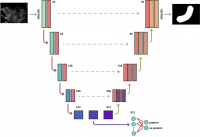How AI helps prevent preterm child birth
A team of researchers associated with the Warsaw University of Technology Faculty of Electronics and Information Technology are working on a dedicated solution.
According to a report by the World Health Organization (WHO), 15 million babies are born spontaneously preterm every year. As many as one million of them die. Many of those who do survive face life-long disability.
Possible issues can be detected through the commonly used manual analysis of ultrasound images but it is by no means a perfect method.
Physicians do recognize this problem. In 2017, Nicole Sochacki-Wójcicka (doing her specialization in Gynecology) and Jakub Wójcicki turned to dr Tomasz Trzciński of the WUT Faculty of Electronics and Information Technology asking about the possibility to carry out a project on spontaneous preterm birth prediction using neural networks.
A research team was then formed and the work started. We already have some preliminary results.
“Our solution is well-positioned to support computer diagnostics and enable more accurate prediction of spontaneous preterm births,” explains Szymon Płotka, a graduate from the Warsaw University of Technology and a member of the project team.
How to train your neural network
“Before the onset of the project, our collaborating physicians prepared a set of training data, validation data and annotations taking the form of outlines of the cervix in ultrasound images and numerical simulations (0 and 1), representing: full-term birth and preterm birth, respectively,” says Szymon Płotka.
Following a preliminary clean-up, these data are used as training data to “train” the neural network, in this case, a convolutional neural network.
“It analyzes every image pixel by pixel to identify the relevant features that will be used to define the segmentation of the part of the image concerned (here, the cervix) and its classification (whether it is a preterm birth or not),” continues Szymon Płotka. “The neural network tests its prediction capabilities on the validation set during the training process. Once the training is completed, the neural network is verified on test data that have not been used for training.
This is how the accuracy of the model so trained is validated.”
One of the kind
Two scientific publications resulted from the project.
The outcomes of the work described in “Estimation of preterm birth markers with U-Net segmentation network” (full text available here and here) include reduction of errors in spontaneous preterm birth prediction from 30%, if done manually by physicians, to 18% by the neural network.
In “Spontaneous preterm birth prediction using convolutional neural networks” (for details see here), the researchers presented an improvement of the segmentation quality on their first publication and achieved better classification results.
“To the best of our knowledge, these are the only existing papers addressing spontaneous preterm birth prediction based on transvaginal ultrasound imaging,” says Szymon Płotka.
The researchers are now working on an online application service. They want to share their neural network models via the app. It is intended to help gynecologists analyze ultrasound images and thus to support the diagnostics of spontaneous preterm births. And this can save lives and health of million of newborn babies.
The project “Opracowanie metody predykcji spontanicznych przedwczesnych porodów na podstawie filmów ultrasonograficznych z wykorzystaniem metod uczenia maszynowego w latach 2020–2021” [Development of a Method for Spontaneous Preterm Birth Prediction Based on Ultrasound Videos Using Machine Learning Methods in 2020–2021] is funded under a Grant of the WUT Scientific Discipline Council Technical IT and Telecommunications.
Project Lead: dr hab. inż. Tomasz Trzciński.
Project Team: currently, the technical part is responsibility of Tomasz Włodarczyk (a Ph.D. student of the Faculty of Electronics and Information Technology), Szymon Płotka (a graduate from the Faculty of Electronics and Information Technology and the author of a master’s thesis under the project), Tomasz Szczepański (a student of the Faculty of Electronics and Information Technology, currently working on his master’s thesis) dr hab. inż. Tomasz Trzciński i prof. dr hab. inż. Przemysław Rokita; medical aspects are responsibility of dr n. med. Michał Lipa, a gynecologist of the Medical University of Warsaw’s University Women's and Newborn Health Center.








